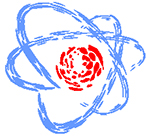Speaker
Mr
Pavel Zolotarev
(SCTMS)
Description
The modification of existing solid electrolyte and cathode materials is a topic of interest for theoreticians and experimentalists and is often related to understanding of the influence of dopants on the performance of the studying materials. For the reason of high complexity of disordered systems configurational space, an application of the computer modeling approaches is hindered. Previously, the Co, Al-doped LiNiO2 cathode configurational space (~22000 entries) obtained within the topological approach as implemented in the ToposPro package was found to fit structural behavior of the cathode during the charging as observed in the neutron diffraction experiment. In the scope of current contribution, in order to provide a precise and self-consistent description of this configurational space we have proposed and evaluated several groups of structural descriptors.
A set of optimized NCA structures corresponding to different Li contents and all independent positions of two Co and one Al dopants in the Ni sublattice was analyzed in terms of the following descriptors 1) Li distribution within the structure, 2) dopants positions in the Ni sublattice, 3) mutual arrangement of the dopants and 4) mutual arrangement of Li and dopants. We observed that the configurations with greater amount of close Al-Li contacts are favorable from the energy viewpoint. Moreover, the effect of Al-Li contacts presence is more pronounced in comparison to Co-Li. Further, the configurations with LiO6 and AlO6 octahedra sharing a common oxygen atom (Li_O_Al) are lower in energy in comparison to those with LiO6 and AlO6 octahedra sharing a common edge (Li_O-O_Al).
The computational studies were supported by the Russian Federation Government (projects No.14.В25.31.0005 and No.3.6588.2017/9.10) and the Russian Foundation for Basic Research (project No.15-43-02194). The work on the neutron diffraction experiments was supported by Russian Science Foundation (project No. 14-12-00896).
Primary author
Mr
Pavel Zolotarev
(SCTMS)
Co-authors
Dr
Ivan Bobrikov
(JINR)
Dr
Roman Eremin
(Samara Center for Theoretical Materials Science, Samara University)

